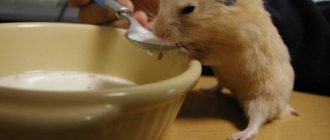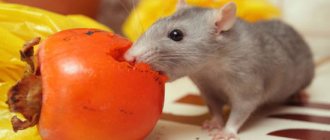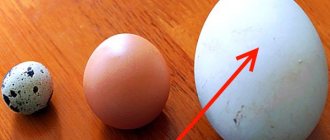To begin with, once again I want to congratulate you - you are very good owners if you first ask what you can give your hamster and what you can’t, and only then feed it to him. Or don't feed. Most people don’t worry about the diet of their Syrian or Djungarian at all. They just shove anything into his feeder. And hamsters are very gentle creatures. You can't do that with them.
What are the benefits of tomatoes for a hamster?
Hamsters, like any living creature, need vitamins. Tomatoes will help make up for the deficiency of the following:
| Vitamins | Why are they needed? |
| C (ascorbic acid) | Participates in the synthesis of hormones, protein metabolism, helps fight infections, improves immunity |
| A (retinol) | Promotes wound healing, tissue regeneration, has a beneficial effect on the health of the eyes, respiratory, digestive, and urinary systems |
| E (tocopherol) | Helps cell restoration, protects them (especially nerve cells), participates in the process of hematopoiesis |
| Group B | Necessary for the functioning of all body systems, primarily the nervous and cardiovascular systems, support metabolism (energy metabolism) |
In addition, vitamins and lycopene have a pronounced antioxidant effect, that is, they are able to protect the animal’s body from the effects of free radicals and protect against cancer.
Hamster and tomatoes
Minerals contained in tomatoes contribute to normal metabolism, in particular hormonal metabolism, strengthening blood vessels and the skeleton:
- calcium and phosphorus are included in connective and bone tissues, in the composition of claws and teeth;
- iodine is necessary for the functioning of the thyroid gland;
- potassium and magnesium are involved in the transmission of nerve impulses to muscles (including the heart).
Tomatoes also contain organic acids (malic, citric), which are necessary for good digestion. Fiber, which is found in large quantities in tomatoes, also contributes to the efficient functioning of the gastrointestinal tract.
Harmful properties
But tomatoes do not always have a positive effect on the health of the rodent. There are a number of contraindications in which consumption should either be limited or excluded from the rodent’s diet altogether. The product cannot be used in cases where:
- The hamster is prone to frequent stomach upsets (diarrhea, diarrhea). The disease is scary because it can lead to dehydration or rectal prolapse.
- Do not give simultaneously with foods high in protein. All together this leads to a slowdown in the digestion process and bloating and flatulence.
- Excluded from the diet if the animal is sick with arthritis or gout.
- Never feed your pet unripe vegetables. Green tomato contains dangerous poison. This type of poisoning can be fatal.
- If a rodent is sick with gastritis or pancreatitis, this is also a reason to exclude tomatoes from its diet.
- Do not feed the vegetable to Syrian hamsters. This type of rodent is susceptible to joint pathologies. And eating it can lead to an exacerbation of the disease.
- It may cause an allergic reaction because it contains dyes. When you treat your pet to this product for the first time, carefully monitor its condition. An allergy can manifest itself as watery eyes, shortness of breath, constant scratching of the skin, and redness on the skin. If this does not happen, you can safely feed him vegetables.
Is it possible to give hamsters tomatoes if they are salted or pickled? - Definitely not. They contain a large amount of salt, which is poorly excreted from the rodent's body. Its excess has a bad effect on the functioning of the cardiovascular system. And if a rodent suffers from kidney disease, then kidney stones may develop.
It is also not recommended to give hamsters vegetables bought in the supermarket in winter. Since there is a high probability that they contain large quantities of nitrates and pesticides. There is no need to give him tomato juice, because the concentration of acidity in it is much higher than in fruits, and the amount of liquid can immediately lead to diarrhea.
Article on the topic: Can hamsters have carrots: benefits and dangers for Djungarian and Syrian breeds
Should you include tomatoes in your hamster's diet?
Considering that the vegetable is so rich in nutrients, experts advise offering it to hamsters, but contraindications must also be taken into account:
- there may be manifestations of allergic reactions;
- if digestive disorders have been observed, they may increase (diarrhea, flatulence, dehydration);
- joint diseases, pancreatitis, gout, if the pet has them, are aggravated.
Hamster and cherry tomato
Tomatoes grown in your own garden are best suited. Greenhouse vegetables out of season should not be given to animals, as the fruits can absorb large amounts of nitrates, which are used for indoor cultivation. In any case, it is better to remove the skin from tomatoes, since it contains a higher content of harmful substances. Green nightshade fruits, which include tomatoes, contain poisonous solanine, so unripe vegetables are also not suitable for feeding hamsters.
In winter, it is even more impossible to replace fresh tomatoes with canned, salted and pickled ones. They contain too much salt and other preservatives (such as vinegar), which will create excessive stress on the digestive and excretory systems of rodents. Dried fruits, tomato paste and juices create a high concentration of acids, which is also harmful for hamsters.
A good option for winter is to grow small cherry tomatoes on the windowsill.
Harmful properties
However, this fruit does not always have a positive effect; there are a number of contraindications that should be taken into account.
- If your hamster has a characteristic stomach upset or frequent diarrhea, the product should be completely excluded from the diet.
- Since tomato contains a large amount of protein, you should not feed foods high in protein. This will lead to disruption of the digestive system.
- An unripe vegetable has a negative effect on the rodent's body. Until death.
- Since the vegetable is red in color, it therefore contains an allergen. Before complementary feeding, it is worth introducing into the diet gradually to avoid unpleasant situations with the hamster’s health. If no allergy symptoms are detected within one day, you can safely introduce this product into your regular diet.
How to feed?
Tomatoes should be introduced into the hamster’s menu gradually. Start literally with 5 grams, observing the pet’s further reaction. In case of negative manifestations (allergies, diarrhea), stop feeding. For clarity: the average size of a cherry fruit is 10 – 30 grams. This is exactly the one-time norm of tomato complementary feeding for an adult rodent. Giving tomatoes to your hamster 1 – 2 days a week will be enough.
Hamster eats tomato
Vegetable foods are easier on the animal's digestion than nutritious grain mixtures high in carbohydrates and proteins. And since hamsters are active at night, it is better to offer them tomatoes in the morning. In this case, it is necessary that there is a sufficient amount of water in the other bowl.
Pregnant and lactating females, as well as cubs, should not be given these vegetables; it is better to choose other vitamin supplements. Tomatoes should not be mixed with protein feed. If your pet refuses to eat vegetables, there is no need to insistently offer them; usually animals instinctively choose what is best for them.
Feeding recommendations
You should not give hamsters tomatoes containing salt or vinegar. It is necessary to exclude barrel and pickled tomatoes. In winter, such food should be removed from the hamster's diet. At this time, I spray the fruits with nitrates and pesticides. Never give tomato juices in any concentration; they contain a large amount of acid. It is good if the fruit is collected in the garden during the period of natural fruiting. There should always be fresh boiled water near the rodent. Hamsters often become very thirsty, especially after feeding like this. If the hamster doesn't like the tomato, there is no need to force it.
Black and white bread
In natural wild conditions, bread is inaccessible to rodents, unless they live near populated areas. Only domestic hamsters can enjoy it, but veterinarians unanimously do not recommend feeding them fresh flour products.
White flour is made from wheat, which is always present in dry mixes, and is acceptable and healthy for your hamster. However, in the process of grinding and processing, grain changes not only its structure, but also its qualitative composition. The product is additionally bleached to make it look presentable and last longer. As a result, the flour is deprived of most of its vitamins, minerals and beneficial fiber.
The resulting starch is a heavy carbohydrate; it can cause obesity in a hamster and, as a result, diabetes, as well as joint problems. In addition, it has the following negative effects on the body:
- negatively affects the functioning of the urinary system;
- provokes disruptions in the normal functioning of the adrenal glands and pancreas;
- leads to disruption of the endocrine system (thyroid gland).
Yeast is added to the dough kneaded for bread, as well as leavening agents, flavorings, stabilizers and other synthetic additives. A hamster's consumption of these completely unhealthful components is fraught with digestive disorders, manifested by increased gas formation and even (in rare cases) alcohol poisoning (due to yeast fermentation). Yeast is especially dangerous because it can radically change the intestinal microflora.
If you give a hamster bread, he will develop quite painful conditions:
- flatulence, vomiting, nausea;
- diarrhea;
- refusal to eat due to loss of appetite;
- breathing problems (choking);
- lethargy and decreased activity;
- heart failure;
- disorientation;
- and even death.
The same attitude applies to black bread, because it is also made with yeast. Although rye flour is less starchy, and there is no need to bleach it, hamsters still cannot eat baked goods from it. The ban is associated with the increased acidity of the baked product, due to which disturbances in the gastrointestinal tract are observed. If you give a hamster rye or black bread, it can cause:
- heartburn;
- gastritis;
- constipation;
- colitis;
- ulcer.
Crackers
If fresh bread has no place on the hamster’s menu, then the attitude towards crackers is different. After all, during heat treatment (drying in an oven), most of the yeast fungi die. Dried bread pieces (both wheat and rye) contain enough fiber, much less carbohydrates, and also contain a number of essential and beneficial minerals (Mg, Fe, Ca). Considered dietary, dried bread no longer causes fermentation; when consuming it, the hamster does not experience flatulence. Rusks normalize the functioning of the gastrointestinal tract and restore metabolic processes in the endocrine system.
On store shelves there is a huge assortment of crackers already prepared and packaged in beautiful wrappers; it is tempting to buy and pamper your pet hamster with them. But this should not be done under any circumstances, since all sorts of flavor enhancers, flavorings and stabilizers are added to purchased products at the factory. These substances, even in small quantities, are deadly to small rodents. It is more desirable and much safer to dry bread yourself, giving preference to grain and bran products.
What can happen if you eat more than you should?
It is not recommended to overfeed the animal. These animals have the habit of hiding food, stocking it up for future use, and at night they can feed on it. Following this, feeding should be done twice a day. Give your pet a larger portion in the evening than in the morning.
A good solution would be to feed succulent foods in the morning, and grains in the evening. Thus, the likelihood of a hamster stocking up on perishable food will be minimal, since it is removed immediately after consumption.
Remember all feeding recommendations when treating your animal to a tomato
This must be done with extreme caution. This way you will prevent health problems for your hamster and help replenish the supply of nutrients in the body.
The health of your pet largely depends on proper nutrition. The basis of a hamster's diet is cereals. But grains and cereals do not contain all the substances necessary for the development and normal functioning of an animal, so vegetables and fruits have to be included in its menu. A large number of vitamins, micro- and macroelements are present in tomatoes.
To give or not?
Can hamsters eat cheese? To answer this question, you need to determine the fat content of the dairy treat. Like all animals, they need foods that contain a lot of protein from time to time.
Rodents are allowed only low-fat cheeses. If this is the type of product you have, you can give your baby a piece that should not exceed the size of a sunflower seed. Such a small portion will benefit your pet.
Often, when choosing cheese for themselves, people give preference to varieties with various flavoring additives, spices and a high salt content. Such a composition will not only be harmful, but even dangerous for the animal. Therefore, you need to buy treats for your hamster separately.
This rule applies to all other products that make up the pet’s diet. By themselves, rodents are not able to distinguish healthy food from harmful food.
Should you give cheese to Djungarian hamsters?
Funny and active animals. Perhaps the most popular species among pet hamsters. They are naturally curious and interested in whatever you offer them.
This type of hamster is extremely susceptible to harmful environmental influences. For this reason, it is better not to give dairy treats to dzhungarikas. In addition, the animals have poor health; their small bodies react to any low-quality food.
Cheese and Syrian hamsters
No less popular among hamster breeders is the Syrian breed. You shouldn't treat this pet with cheese either. The salt and fats contained in the product can harm the fragile body of the animal. Only hard, unsalted, low-fat varieties are allowed in small doses. It is better to choose boiled chicken meat as a source of protein.











